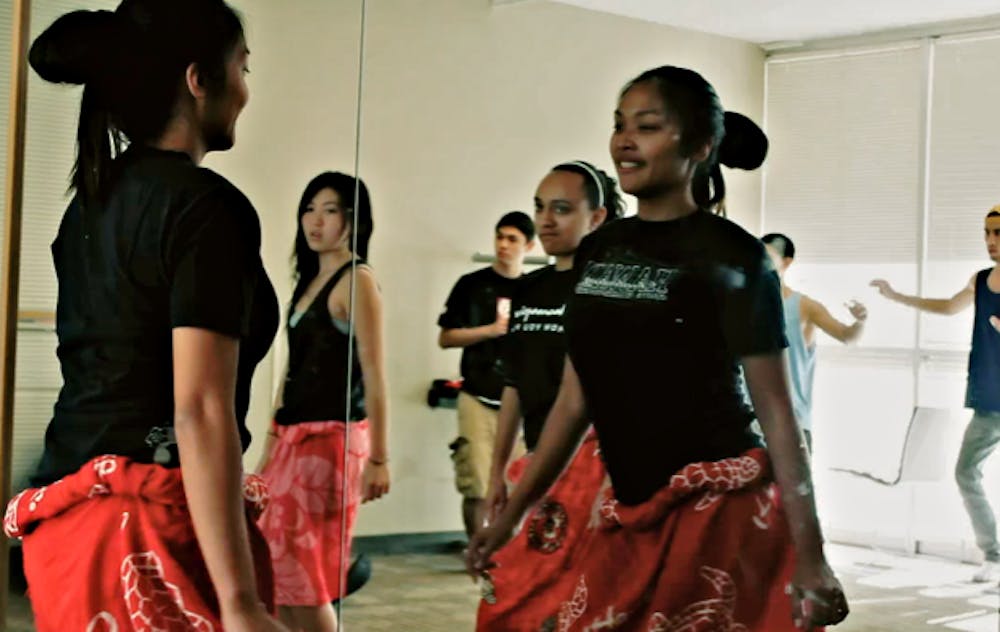On a Sunday morning in late October, while most Arizona State University students are still sleeping, members of the Hawai'i and Pacific Islander Club trickle into a small room in Best Hall on the Tempe campus. They greet each other with kisses on the cheek. Someone turns the music on and a playlist alternates between Hawaiian melodies and hip-hop beats. The students lounge around, discussing the celebration of a member’s 21st birthday last night, before starting dance practice.
The Hawai'i and Pacific Islander Club was revived about three years ago when now-senior Pualeinani Pedrina transferred to ASU from Hawaii Pacific University.
“I was really homesick and I found the club listed on ASU’s website,” says Pedrina, a film and media studies student. “The adviser told me most of the members had graduated but I could make it active again. First it was just three of us that hung out."
Pedrina, now co-president of the club, says there are currently about 35 to 40 active members. The club is for anyone, she says, not just Hawaiians or Pacific Islanders. The club meets throughout the year for socials, practices and performances of traditional Hula and Tahitian dancing.
Their group performs at a variety of student events, such as ones hosted by the Programming Activities Board or even simple backyard barbecues.
“Hawaiian culture is family,” Pedrina says after performing at the Homecoming block party. “That’s what we bring anywhere we go and we always seem to find other Hawaiians. We’re trying to share that and the rest of our culture with other ASU students.”
Secondary education senior Chantel Coloma, also co-president, says one of the main aspects of their culture is dancing. She prefers Tahitian dancing, while Pedrina prefers Hula.
“Hula is a lot slower and more about being graceful in your movements,” Coloma says, running her hand down the edge of her wrap-skirt. “Tahitian is much faster and more about the way you move your hips and your hand gestures, but both types are ways to tell a story.”
Coloma says in Hawaii, taking Hula lessons replaces ballet lessons for children. When Coloma was 8 years old, her mother made her learn Hula, but the little girl soon became bored with the lessons.
“It was just too slow for me,” she says. “But then when I was about 10, my mom had me try Tahitian and I loved it.”
Coloma joined the club because she was interested in continuing her dancing. For her, it’s something that makes her feel at home.
Communications senior Michael Montgomery feels similarly about dancing. Montgomery transferred from a community college in California, but grew up dancing because his family owned a dance production studio.
“I think that’s why I looked for it when I came to ASU, because I was missing dancing,” says Montgomery, the male dance coordinator for the club.
Because he grew up in California and wasn’t as close to his culture as those who grew up in Hawaii or the Pacific Islands, Montgomery finds it especially important to remember his roots.
“My family and I didn’t just practice for shows or competitions. It’s our culture,” Montgomery says. “I feel like it’s almost my duty to spread the culture, spread it right, with others. It’s why I like being in the group, to help educate other people.”
Coloma and Pedrina agree that educating people about their culture is a goal of the club, but all three think the most important thing the club provides is a home away from home.
“I think being from Hawaii makes students more likely to be homesick,” Coloma says. “It’s an arm and a leg to go home, especially for vacation times, like winter break, but that’s when we all want to go home. This club is about making people feel like they are back home, even though it’s obvious we aren’t.”
Coloma recalls when she was a freshman and first met her roommates. When she went to hug them, she saw the confused look on their faces. In Hawaii, she says, everyone hugs everyone. That’s one reason the group tries to recruit freshmen: many students leave after their first year because they miss the islands.
Graphic design freshman Jo-Lynn Kahala-Minczer says she was approached by Pedrina during the first week of school.
“I was just sitting on a bench and she came up to me and asked if I was from Hawaii,” she says. “I asked how she knew and she said she could just tell. And it sounded like a good way for me to feel at home here.”
For Kahala-Minczer, the club and its built-in community has brought home closer to her.
“Where I’m from, there’s one main highway and here, there’s just so many people,” she says. “There’s so much going on here, but you have this club to turn to when you need a bit of home.”
Reach the reporter at sheydt@asu.edu.




